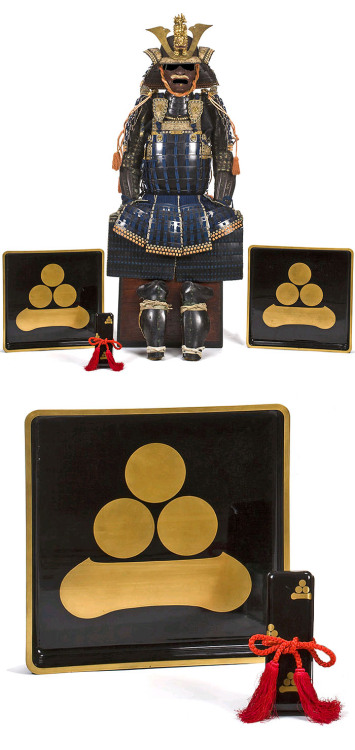Saotome and Myochin Gusoku. Helmet by Saotome Iesada, 18th century, the cuirass by Myochin Soshu, da
Saotome and Myochin Gusoku. Helmet by Saotome Iesada, 18th century, the cuirass by Myochin Soshu, dated 1852Laced in blue with orange and white trim, a sixty-two plate kabuto lacquered russet and adorned with a four-stage tehen kanamono, the wide three-lame shikoro ending in large fukigaeshi applied with stenciled doe skin and Watanabe family heraldic crests, mabisashi decorated to match and finished with a gilt-copper “rope” fukurin, bowl signed Joshu ju Saotome Iesada saku, the kuwagata gilt copper and the large Chinese lion maedate gold lacquer; the russet-lacquer menpo applied with a boar-bristle mustache and chin tuft, fitted with a five-lame hinged yodarekake; the cuirass a mogami do signed Myochin ki Soshu saku kore and dated Ka'ei gonen mizunoene nigatsu hi (a day in the second month of 1852), the munaita and wakiita applied with stenciled doe skin, mounted with seven sections of five-lame kusazuri, gilt-copper hardware; gyoyo applied with gilt-copper Watanabe heraldic crests; osode; kawara haidate; hinged tsubo goteWith two lacquer trays and a document box decorated with Watanabe family heraldic crests in gold hiramakie on a roiro ground.Watanabe familyThe Watanabe were the feudal lords of Musashino province. The first recognized head of the clan was Watanabe Mototsuna (1665-1728). In 1698 they moved to Izumi province where they stayed for 9 generations. In 1871, when the feudal system was dismantled, the Watanabe family were given the title Viscount. -- source link
#samurai#armour#myochin#myochin soshu#saotome iesada#watanabe

